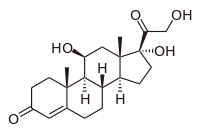
Photo from wikipedia
Mifepristone (RU 486) is a compound that is structurally related to steroid hormones, which is derived from the estrane progestins. This compound strongly binds the progesterone and glucocorticoid receptor and,… Click to show full abstract
Mifepristone (RU 486) is a compound that is structurally related to steroid hormones, which is derived from the estrane progestins. This compound strongly binds the progesterone and glucocorticoid receptor and, to a lesser extent, the androgen receptor. This compound has its effects through different signaling pathways, related to genomic and nongenomic effects. The genomic effect involves the activation or blockage of nuclear or intracellular receptor, that in this case the progesterone, glucocorticoid, and androgen receptors. On the contrary, the nongenomic effect of mifepristone is independent of the activation of these receptors. Regarding the nongenomic, several authors observed that mifepristone induces higher uterine artery blood flow probably due to the decrease in serum nitric oxide level. Moreover, recently it has been demonstrated that mifepristone induces relaxation, and this effect is independent of the endothelium and due to the activation of the calcium channels. The main side effects associated with this pathway are hemorrhage and inhibition of platelet aggregation that can lead to hypovolemia or to hypotension. Concerning the genomic effect, this drug blocks progesterone, androgens, and glucocorticoids receptors and also activates the progesterone receptor and their respective effects. The most frequently reported adverse effects of mifepristone are nausea, vomiting, hypovolemia, hypotension, amenorrhea, and infertility. The main purpose of this review is to describe the genomic and nongenomic effects of mifepristone at vascular level and describe some pathologies in which mifepristone is used as a treatment.
Journal Title: Reproductive Sciences
Year Published: 2017
Link to full text (if available)
Share on Social Media: Sign Up to like & get
recommendations!